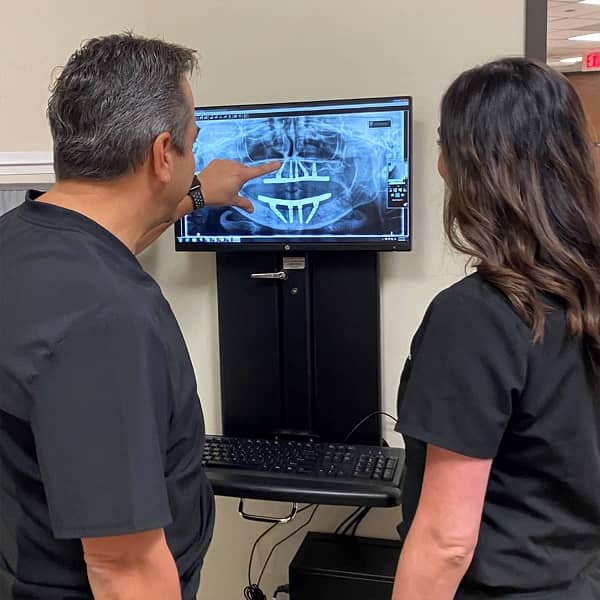We’ve all heard of cat scans or CT scans. Standing for computerized tomography scan, this imaging technology uses computers and rotating X-ray machines to create cross-sectional images of the body. These images provide more detailed information than normal X-rays, as they can show soft tissue, blood vessels, and bones in various parts of the body. For a CT scan, a series of X-rays is taken from different angles. The images are merged in a computer into a 3D image of a particular area of the body.
When that area is the mouth, sinuses, teeth, and jaw, these are made with dental cone beam computed tomography. Dr. Velasco prefers to simply call these our 3D Cat Scans. This incredible technology serves our Houston patients when regular dental or facial X-rays are not providing sufficient information.

What is a 3D Cat Scan?
Dental cone beam computed tomography is a specialized type of X-ray machine. Similar to a CT scan machine, our dental cone beam CT scanners creates three-dimensional images of dental structures, soft tissues, nerve paths, and bone in the craniofacial region in a single scan.
Although they produce very similar types of images, dental cone beam CT scans and conventional CT scans are not the same. The dental cone beam CT version was developed as a means of producing similar types of images but with a much smaller and less expensive machine that could be placed in a dental office.
What are the benefits of having a 3D Cat Scan?
For our Uptown patients this technology can be quite valuable. There are times when a patient comes to our Houston office complaining of tooth or jaw pain. We take a digital X-ray, but it’s not showing Dr. Velasco what or where the problem is. That’s when we tell the patient we’re going to go with a 3D Cat Scan.
A 3D Cat Scan can be adjusted to focus on the problem area and its ability to see through everything which will show us the hidden problem(s). Problems such as fractured teeth and hidden infections within the bone can now be seen, allowing Dr. Velasco to then plan treatment.
What are some common uses of a 3D Cat Scan?
We love our 3D Cat Scan for planning implant placement, looking for clues of TMJ, and plotting orthodontic movement with Invisalign, among many other things. Here is a range of the uses we may employ:
- Diagnosing temporomandibular joint disorder (TMJ)
- Accurate placement of dental implants
- Evaluation of the jaw, sinuses, nerve canals, and nasal cavity
- Detecting, measuring, and treating jaw tumors
- Looking at bone structure, bone mass, and tooth orientation
- Locating the origin of a patient’s pain
- Detect any tooth fractures
What is the difference between a 3D Dental Cat Scan and a regular cat scan?
As mentioned above, our dental cone beam CT scans and regular CT scans both provide detailed images, but the dental cone beam CT does it a bit differently.
Dental cone beam CT scans are relatively new technology. They produce 3D dental imaging using a rotating gantry attached to an X-ray source and detector. Using a cone-shaped source of ionizing radiation that is directed through the area being examined, dental cone beam CTs produce hundreds of planar projection images during a single rotation. These are then merged in the computer to create a 3D image of the face and jaw.
In a regular CT, a fan-shaped beam is used, and the images taken are stacked to create the 3D image. CT scans provide full diagnostic information and are particularly helpful for evaluating soft tissue structures such as muscles, lymph nodes, glands, and nerves. But conventional CT scans also have higher radiation exposure compared to a dental cone beam CT. Conventional CT scanners are also larger and more difficult to use.
How is a 3D Cat Scan done?
These are easy procedures. You stand at the center of the 3D Cat Scan machine and the staff member will help you place your chin on a chin rest. To maintain complete stillness, we have you lightly bite an attached mouthpiece. We center the cone beam directly upon the area we need to see, and the gantry then rotates around you for up to a 360-degree arc. This typically takes between 20 and 40 seconds, and it produces hundreds of planar projection images during a single rotation. For you that’s all there is to it. For the computer, it takes all of the images and combines them to create a single 3D image. That image can be rotated or moved in all directions for the best diagnostic potential.
Is a 3D Cat Scan Safe?
At Uptown, our 3D Cat Scans minimize radiation exposure. In fact, our dental cone beam CT involves up to 10 times less radiation exposure than a standard medical CT scan. This is safe technology that is quick and painless. It helps ensure that we get the most accurate assessment possible of your teeth and jaws. The information gained and accuracy in our diagnoses ensure the benefits of our 3D Cat Scans far outweigh the slight risks of radiation.
Schedule A Consultation
To see the true value of a 3D dental Cat Scan, please call our office today to schedule your next appointment.